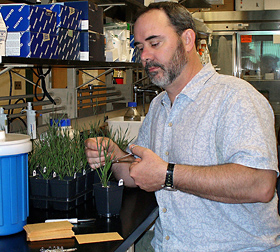This page has been archived and is being provided for reference purposes only. The page is no longer being updated, and therefore, links on the page may be invalid.
Read the magazine story to find out more. |
|
|
New Crop Model Should Speed Resistance to Wheat Diseases
By Don ComisSeptember 8, 2008
An Agricultural Research Service (ARS) scientist's work with a wild grass could help breeders to more quickly develop wheat that's resistant to key diseases.
David Garvin, a plant geneticist at the ARS Plant Science Research Unit in St. Paul, Minn., was perhaps the first scientist in the United States to work on the small grass Brachypodium distachyon as a model species for cereal crops.
Garvin can produce seed in less than two months with some of his Brachypodium genetic stocks. That's important because it reduces the time required to perform experiments that may lead to improved resistance of wheat, barley and other related cereal crops to major diseases like rusts.
Rusts are the most common wheat diseases in the United States and worldwide, causing yearly losses in all wheat market classes. New races of these diseases continually appear in the United States, overcoming the resistance that breeders build and re-build continually into wheat varieties.
His work attracted the attention of John Vogel, the first scientist to see the potential of using Brachypodium as a model for improving grasses like switchgrass for biofuel use. Vogel is a geneticist at the ARS Western Regional Research Center in Albany, Calif.
Together with their ARS colleagues, this team made ARS a leader in getting Brachypodium adopted worldwide as a model for grass research. Seeds of Garvin’s genetic stocks have been shared with research scientists in 25 states and 20 countries.
Garvin has also developed populations of Brachypodium that are being used to create the first genetic maps of Brachypodium.
ARS has given scientists worldwide free access to not only the seeds but also to genes and a draft sequence of the entire Brachypodium genome. This has contributed greatly to the adoption of Brachypodium by plant researchers worldwide as a model grass just a few years since it emerged from obscurity.
Read more about the research in the September 2008 issue of Agricultural Research magazine.
ARS is a scientific research agency of the U.S. Department of Agriculture.

